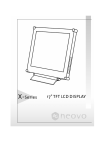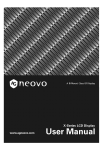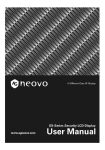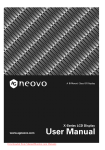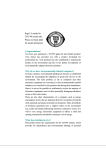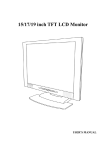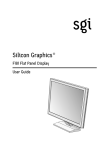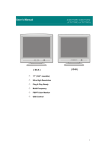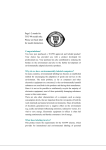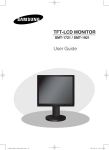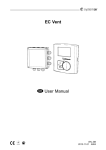Download Untitled - AG Neovo
Transcript
Table of Contents PRECAUTIONS ......................................................................................................................................................2 INSTALLATION ..........................................................................................................................................................2 WARNING ON POWER CONNECTION .......................................................................................................................2 MAINTENANCE........................................................................................................................................................2 TRANSPORTATION ....................................................................................................................................................3 GETTING STARTED ...............................................................................................................................................4 PACKAGE CONTENTS .............................................................................................................................................. 4 IDENTIFYING PARTS AND CONTROLS .......................................................................................................................5 SETUP ......................................................................................................................................................................7 SETUP ......................................................................................................................................................................7 SETTING THE INPUT SIGNAL PRIORITY ..................................................................................................................... 9 INSTALLING INFORMATION FILE FOR MICROSOFT WINDOWS 95/98/2000/ME/XP ......................................... 9 CUSTOMIZING YOUR MONITOR.....................................................................................................................10 WORKING WITH OSD GROUPS ........................................................................................................................... 10 SELECTING THE INPUT ............................................................................................................................................11 PICTURE ADJUSTMENT ...........................................................................................................................................11 AUDIO SETTING..................................................................................................................................................... 13 COLOR TEMPERATURE ........................................................................................................................................... 13 OSD SETTING .......................................................................................................................................................14 MISC SETTING ....................................................................................................................................................... 15 PIP VIDEO QUALITY (OPTIONAL) .......................................................................................................................... 17 PIP ENABLE (OPTIONAL) .......................................................................................................................................18 PIP SETTING (OPTIONAL) .....................................................................................................................................19 INPUT SELECT (OPTIONAL) ...................................................................................................................................20 PICTURE ADJUSTMENT (AV MODE) (OPTIONAL) .................................................................................................. 21 AV MODE (OPTIONAL) ......................................................................................................................................... 22 VOLUME/MUTE ADJUST .......................................................................................................................................23 OSD LOCK FUNCTION ......................................................................................................................................... 24 WARNING MESSAGES AND TROUBLESHOOTING ......................................................................................25 WARNING MESSAGES .......................................................................................................................................... 25 TROUBLESHOOTING ............................................................................................................................................. 26 TECHNICAL FEATURES AND SPECIFICATIONS .........................................................................................................27 SPECIFICATIONS .................................................................................................................................................... 28 REGULATIONS ................................................................................................................................................... 29 FCC COMPLIANCE ................................................................................................................................................ 29 TCO'95 ................................................................................................................................................................30 1 Precautions Installation · Do not cover or block the ventilation holes in the case. · Do not install the monitor near heat sources such as radiators or air ducts, or in a place subject to direct sunlight, excessive dust, mechanical vibration or shock. · Beware not to get your hands caught between the panel and base, when · The power cord set shall have power supply cord according to IEC 60227 and adjusting the viewing angle of the monitor. relevant national standard with conductors providing a cross-sectional area of 3G , 0.75mm2 minimum, type H05VV-F. Warning on power connection · Use an appropriate power cord for your local power supply. · The outlet should be installed near the monitor and be easily accessible. · Do not allow anything to rest on the power cord. · Disconnect the power plug from the power outlet under following conditions: Ø If you will not use it for an indefinite period time. Ø When the power cord or plug is damaged of frayed. Ø If the product has been dropped or the cabinet has been damaged. Ø If the product exhibits a distinct change in performance, indicate a need for service. Maintenance · Clean the cabinet, glass, and controls with a soft cloth lightly moistened with a mild detergent solution. Do not use any type of abrasive pad, scouring powder or solvent, such as alcohol or benzene. · Do not rub, touch, or tap the surface of the screen with sharp or abrasive items such as a pen or screwdriver. This type of contact may result in a scratched glass. · Do not insert sharp objects or spill liquid into the monitor through ventilation holes. They may cause accident fire, electric shock or failure. 2 · Do not attempt to service this product yourself, as opening or removing covers may expose you to dangerous voltage potentials or other risks. Transportation · When you transport this monitor for repair or shipment, use the original carton and packing materials. 3 Getting Started Package Contents Before using this monitor, check the following items are included in your carton box: · Monitor (*1) · Power cord (*1) · D-sub 15-pin VGA signal cable (*1) · Video signal cable adapter (Mini-dim 8-pin connector to S-VHS connector and · S-VHS video signal cable (*1) ( Optional) · USB cable (*1,) · Audio cable (*1,) · Floppy/CD-ROM (containing Windows information file and user’s manual) CVBS jack) (*1) (Optional) 4 Identifying Parts and Controls Front view Power switch Turns the monitor on or off. LED indicator The indicator lights up in green when the monitor is turned on, and lights up in orange when the monitor is in power saving mode. AUTO button Adjust the picture position and performance automatically. You are recommended to press the button the first time you use the monitor or every time you change the resolution and/or refresh rate of the input signal.The (AUTO) function will not work if the input signal is coming from VIDEO-IN connector (DVD,VCD,VCR players, etc.). UP button Activates the On-Screen Display menu. Move the selected item clockwise. Down button Activates the On-Screen Display menu. Move the selected item counterclockwise. Increase button Activates the On-Screen Display menu. Function as the “+” (increase) button when adjusting. Decrease button Activates the On-Screen Display menu. Function as the “-” (decrease) button when adjusting. 5 Rear View VGA In D-sub 15-pin connector for VGA signal. AC power inlet Provides AC power to the monitor. USB upstream port Connects to USB port of computer. USB downstream port Connects to USB devices. Line In Connects to input audio signal. Line Out Connects to external speakers. Video In (Optional) Mini-dim 8-pin connector for S-Video or CVBS signal. 6 Setup Please follow the steps one by one to setup your monitor. 1. Fold the stand of monitor and split the dust-proof plastic sheet Fold the stand out, so you can locate the monitor on the table. Split the dust-proof plastic sheet from the screen surface of monitor. 2. Connect the monitor to the computer or video source With the computer or other video source switched off, connect the video signal cable to the monitor. Ø Connecting to an IBM PC/AT or compatible computer Ø Connecting to a Macintosh or compatible computer Ø Connecting to a video source with S-Video connector. (Optional) Ø Connecting to a video source with CVBS jack. (Optional) 7 3. Connect the power cord With the monitor switched off, connect the power cord to the monitor, and the other end of the power cord to a power outlet. 4. Connect the audio cable. (Line In) port at back of monitor. Connect the audio cable to the And connect the other end to the audio output port of computer or video source. 5. Connect the USB cable. (USB upstream) port at back of monitor. Connect the USB cable to the And connect the other end to the USB port of computer. 6. Turn on the monitor and computer or video source Turn on your computer or other video source. And press (Power) switch to turning on your monitor. You should see the picture on your monitor now. If not, please check the “Warning Signal and Troubleshooting” section of this user manual for details. 8 7. (AUTO) button for best performance Use 1024x768 resolution and press (If you connect to a video source such as DVD or VCR player,please skip this step.) Before starting to work, you are recommended to adjust the resolution of video signal from your computer to 1024x768 at 60Hz for best picture performance. (Please check the user manual of your computer to learn how to adjust the resolution and refresh rate.) You are also recommended to press the (AUTO) button to adjust the picture performance automatically and to ensure the tolerance-free picture. Setting the input signal priority This monitor will detect the video input source (VGA-In or VIDEO-In) automatically. You may switch the input signal priority if both inputs are connected. Please refer to “Customizing Your Monitor” section for details. Installing information file for Microsoft Windows 95/98/2000/ME/XP The information file (also known as driver) for Microsoft Windows 95/98/2000/ME/XP are available in the attached floppy disk or CD-ROM. You may install it for better communication between your monitor and Windows 95/98/2000/ME/XP. Please refer to the text file of “readme.txt” in the attached floppy disk or CD-ROM for details. 9 Working with OSD Groups 1. Press the UP Customizing Your Monitor button to open the OSD main window. OSD functions are divided into Groups. Icons representing these groups appear across the top of the OSD display. From left to right, the OSD Groups are: Picture Adjustment Audio Setting Color Temperature OSD Setting Misc Setting (miscellaneous adjustments) PIP (Picture In Picture) Video Quality (Optional) PIP Enable (Optional) PIP PIP Setting (Optional) Input Select 2. To select an OSD Group, with the OSD window open, press the DOWN UP or buttons until the desired Group’s icon is highlighted and that Group’s setting items are listed. 3. 4. 5. 6. 7. 8. Press the INCREASE menu Group. Use the DOWN or DECREASE or UP button once to enter the setting buttons to select the desired setting from the Group’s displayed menu. With the setting selected, use the INCREASE or DECREASE buttons to change the settings as listed under each setting in the following section. Use the DOWN or UP Push the AUTO button once to save settings and return to the Group selection menu. Push the AUTO buttons to select a new menu item. button again to exit the OSD. The OSD Groups contain adjustment functions as described in the following sections: 10 Selecting the Input The input source is detected automatically when you turn on the monitor. If more than one deivce is connected to the monitor, you can select the device you want from the Input Select screen. 1. button on the front of the monitor. Push the DOWN VGA CVBS S - VIDEO 2. 3. Use the DOWN or UP buttons to move through the items. and DECREASE Use the INCREASE source. buttons to select the input Note! If you select an input source that is not connected to the monitor, you will get a “No Signal” warning. Picture Adjustment OSD BRIGHTNESS CONTRAST H-POSITION V-POSITION CENTER IMAGE CLOCK PHASE WHITE BALANCE 1024 X 768 / 60Hz (+,+) SEP Brightness & Contrast 1. 2. 3. To fine-tune the monitor’s brightness and contrast, select the item from the menu. Use the INCREASE and DECREASE buttons to set the display as desired on the 0-100 scale that appears at the bottom of the window. Push the AUTO selection menu. button once to save settings and return to the Group 11 Horizontal & Vertical Position 1. 2. 3. To fine-tune the display’s position on the monitor screen, select the item from the menu. and DECREASE Use the INCREASE buttons to set the display as desired on the 0-100 scale that appears at the bottom of the window. Push the AUTO selection menu. button once to save settings and return to the Group Center Image 1. 2. 3. To center the display’s position on the monitor screen, select the item from the menu. and DECREASE Use the INCREASE and NO. Push the AUTO button selection menu. buttons to toggle between YES once to save settings and return to the Group Clock & Phase 1. 2. 3. To fine-tune picture performance to compensate for drifts in the computer signal, select the item from the menu. and DECREASE Use the INCREASE buttons to set the display as desired on the 0-100 scale that appears at the bottom of the window. Push the AUTO selection menu. button once to save settings and return to the Group White Balance 1. 2. 3. To enable the monitor’s auto white balance capability, select the item from the menu. Use the INCREASE and NO. Push the AUTO button selection menu. and DECREASE buttons to toggle between YES once to save settings and return to the Group 12 Audio Setting OSD VOLUME ADJUST 1024 X 768 / 60 Hz (+,+) SEP Volume Adjust 1. 2. 3. To adjust the monitor’s built-in speaker volume, select the item from the menu. and DECREASE Use the INCREASE buttons to set the volume as desired on the 0-100 scale that appears at the bottom of the window. once to save settings and return to the Group Push the AUTO button selection menu. Color Temperature OSD 9300 K 6500 K 5500 K USER R G B PRESS - OR + KEY TO CONFIRM 1024 X 768 / 60 Hz (+,+) SEP Selecting a Color Temperature setting The following conditions are recommended for the available settings: Setting Use 9300K General Use 6500K Color Management 5500K Photo Retouching 1. Select the desired setting from the menu. 2. Use the INCREASE and DECREASE 13 buttons to enable the item. 3. Push the AUTO button once to save settings and return to the Group selection menu. Selecting a User-Defined Color Balance Setting You can fine-tune the red/green/blue picture settings according to your preference or specific application. 1. Select the color category from the menu. 2. Use the INCREASE 3. 4. 5. and DECREASE Use the INCREASE and DECREASE desired on the 0-100 scale. or UP Use the DOWN Push the AUTO button selection menu. buttons to enable the item. buttons to set each color as buttons to select the next color. once to save settings and return to the Group OSD Setting OSD OSD POSITION CENTER OSD OSD OFF TIME TRANSPARANCY LANGUAGE 1024 X 768 / 60 Hz (+,+) SEP OSD Position 1. 2. 3. To position the OSD window to your preference, select the item from the menu. Use the INCREASE and DECREASE through its available positions. Push the AUTO button selection menu. buttons to move the display once to save settings and return to the Group Center OSD 1. 2. To center the OSD’s position on the monitor screen, select the item from the menu. Use the INCREASE and DECREASE 14 buttons to toggle between YES and NO. 3. Push the AUTO button selection menu. once to save settings and return to the Group OSD Off Time 1. 2. 3. To set the duration of the OSD window’s display, select the item from the menu. Use the INCREASE and DECREASE desired: off, 10, 20, 30, 40, 50, 60 seconds. Push the AUTO button selection menu. buttons to set the time as once to save settings and return to the Group Transparency 1. 2. 3. To enable transparency of the OSD window, select the item from the menu. Use the INCREASE and DECREASE and NO. Push the AUTO button selection menu. buttons to toggle between YES once to save settings and return to the Group Language 1. 2. 3. To select the language for the OSD interface, select the item from the menu. Use the INCREASE and DECREASE buttons to toggle through the available languages shown at the bottom of the window. Push the AUTO button selection menu. once to save settings and return to the Group Misc Setting OSD CF i RECALL TEXT / GRAPHIC SHARPNESS BACKLIGHT INFORMATION 1024 X 768 / 60 Hz (+,+) SEP 15 Recall 1. 2. 3. To return the monitor’s settings to the factory default, select Recall from the menu. Use the INCREASE and NO. and DECREASE A. Select YES and push the AUTO button buttons to toggle between YES . A warning screen is displayed, and the monitor is reset to the factory defaults. B. Select NO and push the AUTO button selection menu without making changes. once to return to the Group Text/Graphic 1. 2. 3. To choose between the monitor’s automatic sharpness optimization for text or graphic use, select the item from the menu. Use the INCREASE and NO. and DECREASE buttons to toggle between YES once to save settings and return to the Group Push the AUTO button selection menu. Note! For better performance, change to “Text” mode when display resolution is set at 720 x 400 and change to “Graphics” mode when display resolution is set to 640 x 350. Sharpness 1. 2. 3. To set the sharpness of the display, select Sharpness from the menu. Use the INCREASE and DECREASE desired on the Softer-Sharper scale. buttons to set the sharpness as once to save settings and return to the Group Push the AUTO button selection menu. Backlight 1. 2. 3. To set the brightness of the monitor’s backlight, select Backlight from the menu. Use the INCREASE and DECREASE desired on the 1-100 scale. Push the AUTO button selection menu. buttons to set the brightness as once to save settings and return to the Group 16 Information Select Information from the menu to display the monitor’s model number. PIP Video Quality (Optional) PIP (Picture In Picture) allows you to view a small video window in the middle of your full-screen display. Depending on your input source, this feature can be used for watching TV while using your computer. It can also be used in videoconferencing to see how you appear to the other members in the conference. The following screens allow you to change settings for PIP. These changes do not effect full-screen display settings. PIP BRIGHTNESS CONTRAST SATURATION HUE SHARPNESS 1024 X 768 / 60 Hz (+,+) SEP Brightness/Contrast/Saturation/Hue/Sharpness Note! Before you can make changes to the PIP video quality screen, you must enable the PIP feature and choose the source. Refer to the following PIP Enable section for details. 1. 2. 3. To fine-tune these settings for the PIP window, select the item from the menu. Use the INCREASE and DECREASE buttons to set as desired on the 0-100 scale that appears at the bottom of the window. Push the AUTO selection menu. button once to save settings and return to the Group 17 PIP Enable (Optional) To enjoy your monitor’s PIP feature, you should first connect your input source to the rear of the monitor (see Making Connections on page 4). In the following screen, first enable PIP and then select the input source that is connected to the monitor. PIP PIP OFF PIP ON CVBS S - VIDEO 1024 X 768 / 60 Hz (+,+) SEP PIP Off/PIP On 1. 2. 3. 4. 5. Select PIP ON from the menu. Use the INCREASE and DECREASE PIP window appears on your screen.) Use the DOWN or UP window: CVBS; S-VIDEO. Use the INCREASE buttons to select the input source for the PIP and DECREASE source for the PIP window. Push the AUTO button selection menu. buttons to enable PIP. (Notice the buttons to enable the input twice to save settings and return to the Group 18 PIP Setting (Optional) PIP WINDOW SIZE H - POSITION V - POSITION BORDER SIZE BORDER COLOR 1024 X 768 / 60 Hz (+,+) SEP Window Size 1. 2. 3. To resize the PIP window, select the item from the menu. and DECREASE Use the INCREASE buttons to set as desired on the 0/50/100 scale that appears at the bottom of the window. Push the AUTO selection menu. button once to save settings and return to the Group H-Position & V-Position 1. 2. 3. To change the horizontal and vertical position of the PIP window on the monitor screen, select the item from the menu. Use the INCREASE and DECREASE buttons to set the display as desired on the 0-100 scale that appears at the bottom of the window. Push the AUTO selection menu. button once to save settings and return to the Group Border Size & Border Color 1. 2. 3. To change the border size and color of the PIP window, select the item from the menu. Use the INCREASE and DECREASE buttons to set as desired on the 0-100 scale that appears at the bottom of the window. Push the AUTO selection menu. button once to save settings and return to the Group 19 Input Select (Optional) If you only want to change the input source, you can select a simplified version of the following screen by pushing the DOWN button. (See page 11.) PIP VGA CVBS S - VIDEO 720 X 400 / Hz (+,-) SEP VGA/CVBS/S-VIDEO 1. 2. To choose the monitor’s input source, select the item from the menu. Use the INCREASE source. and DECREASE buttons to select the input Note! If you select an input source that is not connected to the monitor, you will get a “No Signal” warning. 20 Picture Adjustment (AV mode) (Optional) If an external video device is connected to the monitor, the PICTURE ADJUSTMENT screens will automatically change as follows. OSD BRIGHTNESS CONTRAST SATURATION HUE SHARPNESS NTSC Brightness/Contrast/Saturation/Hue/Sharpness 1. 2. 3. To adjust these settings, use the DOWN item from the menu. Use the INCREASE Push the AUTO selection menu. and DECREASE or UP buttons select the buttons to set as desired. button once to save settings and return to the Group 21 AV mode (Optional) The AV Mode screen lets you adjust the contrast for the connected video device. Setting Use Mode1 Sets contrast at 25% Mode 2 Sets contrast at 50% Mode 3 Sets contrast at 75% OSD MODE 1 MODE 2 MODE 3 NTSC 1. 2. 3. To adjust these settings, use the DOWN item from the menu. Use the INCREASE Push the AUTO selection menu. and DECREASE or UP buttons select the buttons to set as desired. button once to save settings and return to the Group 22 Volume/Mute Adjust Use the INCREASE and DECREASE of the monitor’s built-in stereo speakers. buttons to quickly adjust the volume Volume VOLUME 80 1. Push the INCREASE button to open the Volume adjust window. 2. Use INCREASE 3. Push the AUTO button and DECREASE adjust window. buttons to set the volume as desired. once to save your setting and close the Volume Audio Enable/Mute AUDIO ENABLE AUDIO MUTE 1. Push the DECREASE 2. Use the DECREASE 3. Push the AUTO button Enable/Mute window. button to open the Audio Enable/Mute window. button to enable Audio Mute. once to save your setting and close the Audio 23 OSD Lock Function Use the OSD lock function to prevent unwanted adjustment of the monitor’s settings. Once the OSD controls are locked, none of the OSD settings including the volume is accessible. Lock/unlock OSD Refer to the following to lock the OSD: 1. Press and hold the DOWN and AUTO seconds. The following screen appears: buttons together for 15 WARNING LOCKING 13 2. OSD Keep pressing both buttons until the counter reaches zero and the screen closes. If you try to access the OSD, a “MAIN CONTROL MENU LOCKED” screen appears. Repeat the above procedure to unlock the OSD. 24 Warning Messages and Troubleshooting Warning Messages If the message appears on the screen CAN NOT DISPLAY THIS INPUT SIGNAL NO SIGNAL INPUT MAIN CONTROL MENU LOCKED NO VIDEO SIGNAL FROM VGA-IN WAIT FOR AUTOMATIC ADJUSTMENT USE 1024X768 FOR BEST PERFORMANCE Check the items The input signal is not acceptable by the monitor. · Please check the video resolution and frequency range is within that specified for the monitor. · Please refer to the “Technical Specifications” section of this user manual for details. No signal inputs are detected from neither VGA-In nor Video-In connector. · Check that the power switch of your computer or video source is in the “ON” position. · Check that the video signal cable is properly connected. · Ensure that no pins are bent or pushed in the video input connector. The main control menu (On-Screen Display menu) is locked to avoid unwanted adjustment. button for 15 seconds to unlock the main control · Press menu. No signal input is detected from VGA-In connector. · Check that the power switch of your computer is in the “ON” position. · Check that the VGA cable is properly connected to VGA-IN connector. · Ensure that no pins are bent or pushed in the video input connector. No signal input is detected from Video-In connector. · Check that the power switch of your video source is in the “ON” postion. · Check that the video cable is properly connected to Video-In connector. The monitor is detecting the input signal and then adjusting automatically the monitor parameters accordantly. · It takes around 5 seconds to finish the whole process. · You are recommended to run auto adjustment by pressing button every time you changed the resolution or refresh rate. The current resolution of video signal is not 1024 by 768. · The performance of this monitor is optimized for resolution of 1024 by 768. You are recommended to change the resolution to 1024 by 768. · Please refer to the user manual of your computer to learn how to change the resolution of video signal. 25 Troubleshooting Symptom · No picture · LED power indicator is not lit · · · · · · · Check Items · Check that the power switch of monitor is turned on. · Check that the power code is properly connected to the monitor. · Check that the power cord is properly connected to power outlet. · Check there is electrical power coming from the power outlet. Use another device to check for power. · Ensure the computer is not in the power saving mode. (Move No picture the mouse or press a key on the keyboard to wake up the The LED power computer.) indicator is orange · Check that the power switch of your computer or video color source is in the “ON” position. · Check that the video signal cable is properly connected. The texts are not solid · Change the resolution of the video signal to 1024 by 768 if it is not. · Press button to run the automatic adjustment. · Adjust Clock and Phase in the OSD menu to fine tune. (Please refer to the “Customizing Your Monitor” section of this user manual for details.) · Adjust Sharpness in the OSD menu if you are not in 1024 by 768 resolution. (Please refer to the “Customizing Your Monitor” section of this user manual for details.) · Press Screen image is not button to run the automatic adjustment. Centered properly · Adjust H. Position and V. Position to fine tune. (Please refer to the “Customizing Your Monitor” section of this user manual Some lines missing for details.) · The TFT LCD panel is made of millions of small transistors. There are red, green, And each defect transistor will cause a missing red, green, or blue or black tiny dots blue dot. on the screen. · It’s guarantees maximum 3 missing dots in every single monitor. It’s around the industrial standard. The USB hub does not · Ensure that the USB cable is properly connected to the USB work. port on the PC and on the base of the monitor. · Ensure that the USB drivers for your PC are properly loaded and configured. 1. Right-click on the “My Computer” icon on your Windows desktop and select “Properties”. 2. Select the “Device Manager” tab and scroll until you see a entry heading “Universal Serial Bus controllers”. 3. Click on the small + sign and check to make sure that both a USB Universal Host Controller and a USB Root Hub are listed, and that there are no yellow circles with an exclamation point or red “X” for either of the devices. · Unplug your USB device and remove the USB drivers in your PC, reinstall your device by following the instruction from screen. Some USB device may conflict with another – remove one of them or contact their suppliers. 26 Technical Features and Specifications Power Saving Function This monitor meets the power-saving guidelines set by VESA and Energy Star, as well as the more stringent NUTEK. If the monitor is connected to a computer that is VESA DPMS (Display Power Management Signaling) compliant, the monitor will automatically reduce power consumption in the three stages as shown below. Mode Screen Power LED indicator Consumption Normal Active < 48 W Green Standby Blank < 5W Orange Power-off Blank <5 W Off Plug & Play This monitor complies with the DDC1 and DDC2B Display Data Channel (DDC) Standards of VESA. Preset and User Modes This monitor has factory preset modes for the 14 most popular industrial standards. Another 14 user modes are also available to store user adjustments. N0. 1 Resolution 640x350 Horizontal Vertical Frequency Frequency 31.5KHz 70Hz Mode IBM VGA 2 640x480 31.5KHz 60Hz IBM VGA 3 640x480 35.0KHz 67Hz Macintosh 4 640x480 37.9KHz 72Hz VGA/72 5 640x480 37.5KHz 75Hz VGA/75 6 720x400 31.5KHz 70Hz IBM VGA 7 800x600 35.2KHz 56Hz SVGA/56 8 800x600 37.9KHz 60Hz SVGA/60 9 800x600 48.1KHz 72Hz SVGA/72 10 800x600 46.9KHz 75Hz SVGA/75 11 832x624 49.7KHz 75Hz Macintosh 12 1024x768 48.4KHz 60Hz XGA/60 13 1024x768 56.5KHz 70Hz XGA/70 14 1024x768 60.0KHz 75Hz XGA/75 27 Specifications Electrical characteristics Screen size 15.0” (381mm) diagonal Pixel format 1024 x 768 vertical stripe Horizontal frequency 30kHz – 60kHz Vertical frequency 50Hz – 75Hz Maximum pixel clock 80MHz Connections Power: 3-pin AC plug AC Power 100 ~ 240V, 50~60Hz < 48W (ON) Consumption < 5W (Standby) < 5W (OFF) Physical characteristics Weight Net: 7.0Kg ( 15.4 lb) Gross: 9.0Kg ( 19.8 lb) Tilt Angle 5º~90º Temperature Operating: 0º - 40ºC Storage: -20º - 60ºC Humidity Operating: 10% - 90% Storage: 5% - 95% 28 Regulations FCC compliance This device complies with Part 15 of the FCC Rules. Operation is subject to the following two conditions: (1) this device may not cause harmful interference, and (2) this device must accept any interference received, including interference that may cause undesired operation. NOTE: This equipment has been tested and found to comply with the limits for a Class B digital device, pursuant to Part 15 of the FCC Rules. These limits are designed to provide reasonable protection against harmful interference in a residential installation. This equipment generates, uses and can radiate radio frequency energy and, if not installed and used in accordance with the instructions, may cause harmful interference to radio communications. However, there is no guarantee that interference will not occur in a particular installation. If this equipment does cause harmful interference to radio or television reception, which can be determined by turning the equipment off and on, the user is encouraged to try to correct the interference by one or more of the following measures: · Reorient or relocate the receiving antenna. · Increase the separation between the equipment and receiver. · Connect the equipment to an outlet on a circuit different from that to which · Consult the dealer or an experienced radio/TV technician for help. the receiver is connected. WARNING: Any unauthorized modification to this equipment could result in the revocation of the authorization to operate the equipment and void the product warranty. 29 TCO'95 Congratulations! You have just purchased a TCO'95 approved and labelled product! Your choice has provided you with a product developed for professional use. Your purchase has also contributed to reducing the burden on the environment and also to the further development of environmentally adapted electronics products. Why do we have environmentally labelled computers? In many countries, environmental labelling has become an established method for encouraging the adaptation of goods and services to the environment. The main problem, as far as computers and other electronics equipment are concerned, is that environmentally harmful substances are used both in the products and during the manufacturing. Since it has not been possible for the majority of electronics equipment to be recycled in a satisfactory way, most of these potentially damaging substances sooner or later enter nature. There are also other characteristics of a computer, such as energy consumption levels, that are important from the viewpoints of both the work (internal) and natural (external) environments. Since all methods of conventional electricity generation have a negative effect on the environment (acidic and climate-influencing emissions, radioactive waste, etc.), it is vital to conserve energy. Electronics equipment in offices consume an enormous amount of energy since they are often left running continuously. What does labelling involve? This product meets the requirements for the TCO'95 scheme which provides for international and environmental labelling of personal computers. The labelling scheme was developed as a joint effort by the TCO (The Swedish Confederation of Professional Employees), Naturskyddsforeningen (The Swedish Society for Nature Conservation) and NUTEK (The National Board for Industrial and Technical Development in Sweden). The requirements cover a wide range of issues: environment, ergonomics, usability, emission of electrical and magnetic fields, energy consumption and electrical and fire safety. The environmental demands concern restrictions on the presence and use of heavy metals, brominated and chlorinated flame retardants, CFCs (freons) and chlorinated solvents, among other things. The product must be prepared for recycling and the manufacturer is obliged to have an environmental plan which must be adhered to in each country where the company implements its operational policy. The energy requirements include a demand that the computer and/or display, after a certain period of inactivity, shall reduce its power consumption to a lower level in one or more stages. The length of time to reactivate the computer shall be reasonable for the user. Labelled products must meet strict environmental demands, for example, in respect of the reduction of electric and magnetic fields, physical and visual ergonomics and good usability. On the back page of this folder, you will find a brief summary of the environmental requirements met by this product. The complete environmental criteria document may be ordered from: TCO Development Unit 30 S-114 94 Stockholm, Sweden Fax: +46 8 782 92 07 Email (Internet): [email protected] Current information regarding TCO'95 approved and labelled products may also be obtained via the Internet, using the address: http://www.tco-info.com/ TCO’95 is a co-operative project between TCO (The Swedish Confederation of Professional Employees), Naturskyddsforeningen (The Swedish Society for Nature Conservation) and NUTEK (The National Board for Industrial and Technical Development in Sweden). Environmental requirements Brominated flame retardants Brominated flame retardants are present in printed circuit boards, cables, wires, casings and housings. In turn, they delay the spread of fire. Up to thirty percent of the plastic in a computer casing can consist of flame retardant substances. There are related to another group of environmental toxins, PCBs which are suspected to give rise to similar harm, including reproductive damage in fisheating birds and mammals, due to the bio-accumulative processes. Flame retardants have been found in human blood and researchers fear that disturbances in foetus development may occur. TCO'95 demand requires that plastic components weighing more than 25 grams must not contain organically bound chlorine and bromine. Lead** Lead can be found in picture tubes, display screens, solders and capacitors. Lead damages the nervous system and in higher doses, causes lead poisoning. TCO’95 requirement permits the inclusion of lead since no replacement has yet been developed. Cadmium** Cadmium is present in rechargeable batteries and in the colour-generating layers of certain computer displays. Cadmium damages the nervous system and is toxic in high doses. TCO'95 requirement states that batteries may not contain more than 25 ppm (parts per million) of cadmium. The colour-generating layers of display screens must not contain any cadmium. Mercury** Mercury is sometimes found in batteries, relays and switches. Mercury damages the nervous system and is toxic in high doses. TCO'95 requirement states that batteries may not contain more than 25 ppm (parts per million) of mercury. It also demands that no mercury is present in any of the electrical or electronics components concerned with the display unit. CFCs (freons) CFCs (freons) are sometimes used for washing printed circuit boards and in the manufacturing of expanded foam for packaging. CFCs break down ozone and thereby damage the ozone layer in the stratosphere, causing increased reception on earth of ultraviolet light with consequent increased risks of skin cancer (malignant melanoma). The relevant TCO'95 requirement: Neither CFCs nor HCFCs may be used during the manufacturing of the product or its packaging. 1 *Bio-accumulative is defined as substances, which accumulate within living organisms **Lead, Cadmium and Mercury are heavy metals which are Bio-accumulative. 31
































